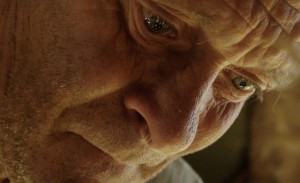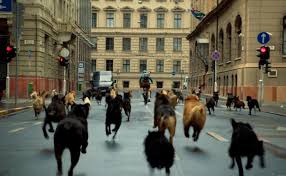I’ve chosen 5 films at this year’s “New Directors/New Films” festival – a joint production of MOMA and Lincoln Center Film Society – and I’ve found it as stimulating as ever. Here’s my rundown, in order of viewing.
The Creation of Meaning is a title that tells you what the filmmaker wants to do, but nothing about the film you can expect to see. Returning to his native Italy, after living in Canada for several years, Director-writer Simone Rapisarda Casanova chose an elderly shepherd, Pacifico, as the subject for his film, and had him agree to “perform” – as himself – in a chronicle of Italy’s woeful economy and the lingering painful memories of World War II. Filmed in the Apennine mountains in Tuscany, it presents a challenging view of cultural resistance to progress. More of a mosaic than a narrative, it has Pacifico and other “villagers” describing the deaths and sufferings in the village during the war, much of which had been told to them by survivors who have long since died. While the actors are non-professionals, they are supplied dialogue and given “memories” to describe that may, or may not, be from their own experience.
In writing about the film, I have tried to assume the viewpoint of someone who is unaware of Casanova’s method of working. Many admirers of the film described how he became interested in the people he met while filming it, which influenced his script. But I am still not clear about what Casanova wants the audience to accept as “true”, and what is only from his imagination.
Still, there are some effective scenes, including a lengthy one where Pacifico shows a gun expert his collection of cartridge shells that he has found over the years, and the final scene, where he talks to the man who bought his house, a German, about how Italians and Germans have largely overcome their bitterness due to mutual commercial interests. The latter scene entertains because the German’s toddler child is present throughout, doing what adorable toddlers always do. Of course this cannot help but distract us – charmingly – from what the adults are saying, but it provides an amusing interlude in an often confusing narrative.
While interesting and often beautiful – the scenes of the Tuscan mountains and countryside are lovely – the overall effect of Casanova’s technique is more unsettling than dramatically satisfying. He seems resigned, yet resentful in a way, to the fact that people so easily forget the past, a tendency that is fully exploited by their political leaders. This is a familiar subject in films; I respect Casanova’s original way of presenting it, but, like the awesome mountain mists of Tuscany, the film fades before our eyes.
White God has gotten a lot of pre-screening buzz, and it was shown only a week before a limited opening. Guaranteed to inspire controversy, it seems a perfect fit for ND/NF. Writer-director Komel Mundruczo has made a corrosive satire of life class/race oppression in modern Hungary. In this case, the victims are “mixed breed” street dogs, or “mutts”, who are routinely caught and placed in shelters where, unless they are selected as pets, they will all be “euthanized”. The story concerns a13-year old girl, Lili, whose parents are divorced, and her dog, Hagen, a mixed-breed who follows her obsessively. Problems ensue when Lili and Hagen are left with Lili’s father, who agrees to care for her while the girl’s mother is away. Lili’s father fiercely objects to the dog as “low-class” and filthy, as does a woman neighbor, who contacts the police. It seems that all owners of mixed breeds are required to pay a tax, but Lili’s father refuses. Outraged, he strands the dog by the highway, leaving Lili in hysterics. Hagen’s subsequent adventures in the city are a harrowing display of abuse by an assortment of lowlifes, culminating in a terrifying dogfight in an illegal gambling den. Once again stranded, Hagen is caught and brought to the shelter, where he faces almost certain death.
The final and most violent section of the film shows Hagen breaking out of the shelter – after mauling a guard – and leading hundreds of other dogs on a rampage of revenge through the streets of Budapest. Although random citizens are also attacked, the dogs follow Hagen to seek out and kill all of the people, both men and women, who had abused him. The film most departs from realism here, since the dogs improbably resemble an “organized army” following its general, as is noted in a news bulletin. The film forcefully compares society’s treatment of animals with how it treats people it also considers “low-class” and a “menace”, and shows how race and class are its cause. While this comparison is somewhat superficial – no one mentions that packs of dogs roaming the street may be a real health and safety hazard, for instance – we recognize that the cruelty in society’s treatment of them is similar. But, whatever you think of the analogy, the film’s cinematic power is felt in its amazing scenes of the dogs being used as hundreds of precisely choreographed extras, suggesting a mob of people toppling a corrupt government. The filmmakers maintain that real street dogs were trained and filmed throughout, with no CGI “assistance” at all. This is especially amazing in the final shot, cannily ending the film with emotional uplift. I’m still shaking my head over how they were able to do it.
The kindergarten Teacher is one of those rare films that operate on many levels, but never loses its footing. Director-writer Nadav Lapid told the audience at the screening that the inspiration for the film came from his re-discovery of poems that he wrote when he was seven years old. The film focuses on the relationship between Nira, the teacher of the title, with a five-year old boy in her class who creates poetry. The boy, Yoav, retreats into his private world at moments of stress, pacing back and forth while reciting complete poems, beginning-to-end without interruption. His nanny, an actress, writes them down and sometimes recites them, without attribution, at auditions, which Nira finds reprehensible. She believes that Yoav’s genius, comparable to Mozart’s, is a gift to all mankind. Although happily married, with two healthy young adult children, she is troubled by a world where people persist in treating each other with cruelty, in Israel and everywhere else. An unpublished poet herself, she makes it her personal mission to promote Yoav’s poetry.
From early on, we can sense that Nira is an obsessive personality, which has begun to distort her relationship with Yoav. Sarit Larry’s remarkable performance conveys the intensity of this obsession, and our unease only deepens because of Nira’s extreme intelligence and ability to manipulate others. But Lapid deviates, subtly, from traditional melodrama. Underlying the suspense, as based on our concern for Yoav’s safety, is Lapid’s compassion for his disturbed heroine. We see that her conversations with the boy – her often eloquent questioning about what he understands of the adult world around him – are meant to inspire him to save the world, which needs his poetry now more than ever. I don’t know that an audience, unaware of Lapid’s childhood, can get the irony here. Lapid abandoned poetry early in life, but he chose to make films instead. The idea of a child saving the world with poetry is ludicrous, and nothing in the film suggests otherwise. But a filmmaker? Does Lapid believe that becoming a filmmaker is just as futile? I suspect he retains a certain idealistic conception of the power of art, and that this is something he shares with the delusional kindergarten teacher in the story.
Goodnight, Mommy is one of those films that has a kicker at the end so that you replay the whole film in your mind to see what clues you missed. I never expected it, but one person in my party wasn’t fooled. Even so, it’s not the best example of that kind of film that I’ve seen. An Austrian film, it opens with a pair of twin boys, Elias and Lukas, age 10, playing hide and seek in the tall grass. They go back to their house, a modern ranch-design in the countryside by a lake, and are greeted, icily, by their mother, whose face is swathed in bandages from surgery. We find out there had been a terrible accident, which is never explained. During the course of the story, we witness the mother’s increasing cruelty to both boys, especially to Lukas. The boys become resentful that she is trying to keep them apart, and they plot against her. They believe she is not really their mother at all, and will keep her a prisoner until she reveals what happened to “mommy”.
That’s the mechanics of the thing in its entirety. The formula has been reliable in the past (think The Sixth Sense), but the devil is in the details. The surprise only works if we believe in the reality of what we are being presented first; the revealed “truth” will not make sense otherwise. But I thought the boys’ mother was never a credible character on any level. I saw nothing that indicated there had ever been a stable family relationship even before the mysterious accident. I could just have easily believed she was a “body snatcher” pod from another planet. That said, the writer- co-directors Severin Fiala and Veronika Franz obviously know their way around genre movies, and there is some wry humor on view. The psychological substructure of twins allows for some fascinating analysis, and presents rich material for the horror genre. But for me, this story didn’t work.
Entertainment, which closed the series, is the hardest to write about. Director Rick Alverson co-wrote it with Tim Heidecker. The star, Gregg Turkington, is a real comedian who uses the name Neil Hamburger, and the film is a kind of nightmare-comedy about his life on tour. Like Andy Kaufman or “Professor” Irwin Corey, he appears before an audience as a complete persona, a genuinely odd person who just happens to make his living as an entertainer. Odd, maybe, but more likely plain nuts. In a rumpled suit, glasses and greasy, uncombed hair, he screams his weird but often funny material into a microphone, and then waits, grimly, for laughter. He appears to be suffering throughout, and a heckler turns him hostile to the point of hysteria.
The film opens with him performing before a “captive” audience; prisoners in a New Mexico state pen. His act is preceded by a clown, a young man with red nose who does an energetic chicken dance. The two often perform at the same shows, but barely talk to each other. Gregg’s turn gets polite, if bewildered, appreciation from the prisoners, but that’s about as good as it ever gets. His usual venue is a bar in a one cactus town in the Southwest. Those patrons are either bug-eyed drunk or hostile, but usually both. He meets an assortment of people on his journeys that are only slightly less odd than himself: his cousin, played by John C. Reilly, who treats him to a lunch where he sings a Christian hymn; a young man, played by Michael Cera, who wants him to keep him company in a public toilet while waiting for triple-A repairs; a pregnant woman whose baby he delivers, stillborn, also in a public toilet (the film’s most frequent set); and a woman heckler who physically assaults him. The film ends pretty much as it started, with Gregg ready to go to another gig, as if it were a station of the cross.
Alverson uses the wide screen well. The flat, barren landscape of the southwest seems an apt counterpoint to Eric’s constant loneliness and isolation. The filmmaker’s best choice, however, was the casting of Gregg in itself. He is a fascinating, charismatic performer and we keep watching to learn more about him. It is the only suspense in a dramatically static movie. We only know he has a daughter he calls every night, but who never answers or returns his calls. When asked, he says that he has no other goal tin life than to continue performing as long as he can, but he is so thoroughly miserable doing this that we think there must be something in his background to account for such masochism.
Alas, we never find out. Perhaps Alverson thinks this makes the film more “enigmatic”, so as to inspire heated late-night discussions. But another explanation – one which grants him more integrity, if not the best judgment – is that he wants to have the film audience react with the same frustrated hostility that Gregg provokes in the drunken morons who see his act.





